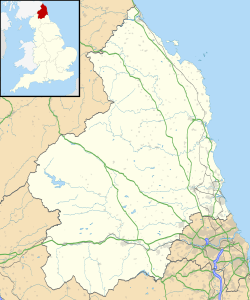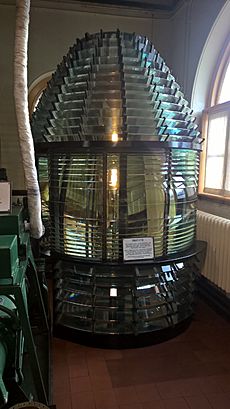Coquet Island facts for kids
 |
|
| Geography | |
|---|---|
| Location | North Sea |
| Coordinates | 55°20′06″N 1°32′20″W / 55.335°N 1.539°W |
| OS grid reference | NU293046 |
| Area | 6 ha (15 acres) |
| Administration | |
Coquet Island is a small island located about 1.2 kilometers (0.75 miles) off the coast of Amble in northeast England. It's in Northumberland and is about 6 hectares (15 acres) in size.
Contents
A Special Home for Birds
The island is owned by the Duke of Northumberland. It is managed as a bird reserve by the Royal Society for the Protection of Birds (RSPB). This makes Coquet Island a very important place for many different types of seabirds.
Puffins and Terns
One of the most common birds here is the Atlantic puffin. In 2002, over 18,000 pairs of puffins nested on the island! They are famous for their colorful beaks and clumsy flight.
Coquet Island is also super important for the roseate tern. This bird is quite rare in Britain. Thanks to special efforts, like providing nest boxes to protect their eggs from gulls and bad weather, their numbers have grown. In 2018, there were 118 pairs nesting here.
Other birds that nest on the island include sandwich terns, common terns, and Arctic terns. You can also find black-legged kittiwakes, fulmars, and eider ducks.
Visiting the Island
No one lives on Coquet Island during the winter. But in the summer, wardens stay there to protect the nesting birds. People are not allowed to land on the island to keep the birds safe.
However, you can still see the amazing birds! Local boat companies in Amble offer trips that sail close to the island. This lets visitors get a great view of the puffins and roseate terns, especially during the summer.
Coquet Lighthouse: A Guiding Light
| Location | Coquet Island Northumberland England |
|---|---|
| Coordinates | 55°20′2″N 1°32′23.2″W / 55.33389°N 1.539778°W |
| Year first constructed | 1841 |
| Automated | 1990 |
| Construction | sandstone tower |
| Tower shape | square tower with balcony and lantern |
| Markings / pattern | unpainted lower tower, white upper tower and lantern |
| Height | 22 m (72 ft) |
| Focal height | 25 m (82 ft) |
| Original lens | 1st order catadioptric fixed lens |
| Intensity | white: 155,000 candela red: 21,830 candela |
| Range | white: 19 nmi (35 km) red: 15 nmi (28 km) |
| Characteristic | Fl (3) WR 20s. |
| Fog signal | one 2 second blast every 30s. |
Coquet Island has a long history. A man named Henry of Coquet lived there as a hermit around the year 1127. There are also parts of an old medieval monastery on the island's southwest side. These old structures were later used when the lighthouse was built.
Building the Lighthouse
The Coquet Lighthouse was built in 1841 by Trinity House, an organization that manages lighthouses. It cost £3,268 to build. The lighthouse was designed by James Walker. It is a white, square tower made of sandstone, with very thick walls.
The first lighthouse keeper at Coquet was William Darling. He was the older brother of Grace Darling, who was famous for rescuing shipwrecked sailors.
How the Light Works
When it was first built, the lighthouse used a special lens called a dioptric lens and mirrors to make the light strong. This lens was made in Newcastle upon Tyne. The lamp was powered by oil.
Later, in 1854, red lights were added. These red lights warned ships about dangerous areas like Hauxley Point and Boulmer Rocks. In 1891, the main light became much brighter. It also started to "occult," meaning it would go dark for 2.5 seconds every minute.
Fog Signals and Modern Changes
In 1902, an explosive fog signal was added. This signal would make a loud blast to warn ships when it was foggy. It first sounded every seven-and-a-half minutes, then every three minutes.
The lighthouse became electric in 1976. Before that, it used paraffin oil for its light. In 1990, the lighthouse became automated, meaning no keepers were needed anymore. The old lens was replaced with modern lamps that flash three times every 30 seconds. Since 2008, Coquet's light has been powered by solar energy, making it very eco-friendly!
The original lens from 1841 was displayed in a museum for many years. It showed how lighthouses used to work.




